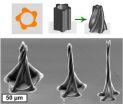How green is your campus?
Motivations for sustainability for universities vs. for-profit companies
2010-10-20
(Press-News.org) Williamsburg, VA —October 19, 2010— Corporations and individuals alike are increasingly focused on "going green," in an attempt to reduce their carbon footprint and impact on the environment. It is questionable whether higher education institutions are adopting sustainable practices at the same rate, despite large consumption rates of energy and water, among other resources. In the first study of its kind, Contemporary Economic Policy presents an article which compares the factors that drive colleges to adopt sustainable practices to the factors that motivate for-profit companies to "go green."
Dr. Sarah L. Stafford, Professor of Economics at the College of William and Mary, utilized data on campus sustainability grades originally developed by the Sustainable Endowments Institute, with information from over 180 universities. Her research analyzes the factors that had a significant effect on campus sustainability rating, including regulatory pressures, financial constraints, student preferences, and pressure from stakeholders such as faculty, alumni, and the surrounding community.
Stafford remarks, "The size of the university, their endowment, and the opinions of the faculty, alumni, and the local community are all highly influential in whether colleges adopt sustainable practices. I found that the decision to adopt sustainable policies was not at all related to the goal to attract students. For-profit companies pursue sustainable practices to increase their environmental performance due to regulatory pressures, but universities are not influenced by these factors."
Stafford's research speaks to the fact that if government or non-profits wish to increase sustainability on college campuses they will need to use different policies than what is currently used for corporations. Stafford points out that the decision of college presidents to sign the Presidents Climate Commitment (PCC) was mainly a symbolic gesture and motivated by quite different reasons for pursuing overall sustainability. Most importantly, institutional wealth and size were not significant factors in that decision.
Stafford concludes, "Since wealth and size make it more likely that a campus will adopt sustainable practices, efforts to subsidize campus sustainability or provide technical assistance to smaller institutions might be the most successful strategy to encourage campuses to adopt green practices. Smaller institutions may in the future be able to utilize sustainability initiatives to attract students interested in attending a university with green practices, and establish a unique position among higher education institutions. Top-ranked schools normally attract more qualified candidates than lower ranked schools and typically do not use sustainability initiatives to attract students."
INFORMATION:
This study will be published in a forthcoming issue of Contemporary Economic Policy . Members of the media may request a full-text version of this article by contacting scholarlynews@wiley.com.
To view an abstract of this article please visit http://onlinelibrary.wiley.com/doi/10.1111/j.1465-7287.2010.00231.x/abstract.
Article: "How Green Is Your Campus? An Analysis of the Factors that Drive Universities to Embrace Sustainability." Sarah L. Stafford. Contemporary Economic Policy; Published Online: October 18, 2010 (DOI: 10.1111/j.1465-7287.2010.00231.x).
Dr. Sarah L. Stafford is a Paul R. Verkuil Distinguished Professor of Public Policy, Economics, and Law at the College of William and Mary. Dr. Stafford's has widely published on topics of corporate environmental behavior, environmental economics and regulation, and law and economics. She has received grants from the National Science Foundation, the Environmental Protection Agency's Science to Achieve Results Program, and the Resources for the Future, a non-partisan environmental think tank. She can be reached for questions at slstaf@wm.edu.
Contemporary Economic Policy publishes scholarly economic research and analysis on issues of vital concern to business, government, and other decision makers. Leading western scholars, including three Nobel laureates, are among CEP's authors. The objectives are to communicate results of high quality economic analysis to policymakers, focus high quality research and analysis on current policy issues of widespread concern, increase knowledge among economists of features of the economy key to understanding the impact of policy, and to advance methods of policy analysis.
About Wiley-Blackwell
Wiley-Blackwell is the international scientific, technical, medical, and scholarly publishing business of John Wiley & Sons, with strengths in every major academic and professional field and partnerships with many of the world's leading societies. Wiley-Blackwell publishes nearly 1,500 peer-reviewed journals and 1,500+ new books annually in print and online, as well as databases, major reference works and laboratory protocols. For more information, please visit www.wileyblackwell.com or our new online platform, Wiley Online Library (wileyonlinelibrary.com), one of the world's most extensive multidisciplinary collections of online resources, covering life, health, social and physical sciences, and humanities.
ELSE PRESS RELEASES FROM THIS DATE:
2010-10-20
ATLANTA—October 19, 2010—A rare and deadly form of breast cancer that often goes unrecognized by clinicians and patients alike is the focus of a new report from leading researchers. Inflammatory breast cancer (IBC) has made headlines as an unrecognized and misunderstood form of breast cancer. It has a younger age of onset, progresses rapidly, and has lower overall survival compared to other breast cancers. For the new report, leading researchers led by Massimo Cristofanilli, M.D., of Fox Chase Cancer Center in Philadelphia outline IBC's unique clinical presentation, pathology, ...
2010-10-20
Montreal, October 19, 2010 – Dogs may not only be man's best friend, they may also have a special role in the lives of children with special needs. According to a new Université de Montreal study, specifically trained service dogs can help reduce the anxiety and enhance the socialization skills of children with Autism Syndrome Disorders (ASDs). The findings published this year in Psychoneuroendocrinology may be a relatively simple solution to help affected children and their families cope with these challenging disorders.
"Our findings showed that the dogs had a clear ...
2010-10-20
Flexible circuits can be found in many devices where space and weight considerations are dominant in the design of electronics: in cars, in cameras and video equipment, in mini-computers for athletes or in inkjet printers. And the market continues to grow: according to the business consultancy Frost & Sullivan, sales in this area will grow to more than $16 billion by the year 2014.
At K 2010, the trade fair for plastics in Düsseldorf, Germany, scientists from the IST in Braunschweig will unveil a new reel-to-reel technology for the production of flexible circuits and ...
2010-10-20
CHAMPAIGN, Ill. – In the battle of egos, Donald Trump vs. Hugo Chavez might be a draw. But as symbols of power, each resonates differently with different cultures, as cultures nurture different views of what is desirable and meaningful to do with power, according to new research by a University of Illinois marketing expert.
Sharon Shavitt says the relation between culture and one's concepts of power emerge from one's cultural orientation, and how that culture shapes one's beliefs, attitudes and goals.
"People's views of powerful people and what powerful people are supposed ...
2010-10-20
HOUSTON -- (Oct. 19, 2010) -- Some bacteria react to the cold by subtly changing the chemistry of their outer wall so that it remains pliable as temperatures drop. Scientists identified a key protein in this response mechanism a few years ago, but the question of how bacteria sense cold in the first place remained a mystery. Based on a study by scientists at Rice University and Argentina's National University of Rosario, the answer is: They use a measuring stick.
The study, published in the September issue of Current Biology, involved a series of intricate experiments ...
2010-10-20
ANN ARBOR, Mich.---A drug marketed to grow bone in osteoporosis patients also works to heal bone wounds in gum disease patients, a University of Michigan study suggests.
"This new approach for the treatment of periodontal disease could allow us to rebuild some of the bone that is lost due to periodontal disease, which until this point has been very difficult to achieve," said Jill Bashutski, clinical assistant professor at the U-M School of Dentistry and first author on the study. "Current treatments to re-grow bone around teeth affected with gum disease have limited ...
2010-10-20
Conventional wisdom holds that people try to mimic the behavior of the next social class above their own.
Except when it comes to shopping at secondhand stores and yard sales, concludes a new study by Brigham Young University sociology students and faculty.
The study found that high-income shoppers scour the secondhand market for antiques, but everyone else is trying to stretch the family dollar.
"Middle-class shoppers were looking for furniture, some appliances, clothes, things that you could argue are necessities," said BYU sociology professor Ralph Brown. "There's ...
2010-10-20
Seeing a child or a dog play is not a foreign sight. But what about a turtle or even a wasp?
Apparently, they play, too.
In fact, according to Gordon Burghardt, a psychology professor at the University of Tennessee, Knoxville, many animals -- not just dogs, cats, and monkeys -- need a little play time.
"I studied the behavior of baby and juvenile reptiles for many years and never saw anything that I thought was play. Then I had an epiphany when I saw Pigface, a Nile softshell turtle, batting around a basketball at the National Zoo in Washington, D.C. I realized ...
2010-10-20
CLEVELAND – In a first-of-its-kind clinical trial, physicians at University Hospitals (UH) Case Medical Center who are Case Western Reserve University School of Medicine researchers are exploring the role of Vitamin D in preventing esophageal cancer. Principal Investigator Linda Cummings, MD, along with Amitabh Chak, MD, and Gregory Cooper, MD, from the UH Digestive Health Institute, is recruiting patients with Barrett's esophagus to measure the effects of Vitamin D on protein levels that may influence the risk of developing esophageal cancer.
"Vitamin D is being studied ...
2010-10-20
ANN ARBOR, Mich.---Twisting spires, concentric rings, and gracefully bending petals are a few of the new three-dimensional shapes that University of Michigan engineers can make from carbon nanotubes using a new manufacturing process.
The process is called "capillary forming," and it takes advantage of capillary action, the phenomenon at work when liquids seem to defy gravity and travel up a drinking straw of their own accord.
The new miniature shapes, which are difficult if not impossible to build using any material, have the potential to harness the exceptional mechanical, ...
LAST 30 PRESS RELEASES:
[Press-News.org] How green is your campus?
Motivations for sustainability for universities vs. for-profit companies


